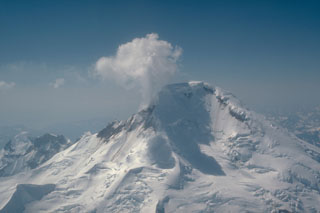Report on Iliamna (United States) — 31 May-6 June 2023
Smithsonian Institution / US Geological Survey
Weekly Volcanic Activity Report, 31 May-6 June 2023
Managing Editor: Sally Sennert.
Please cite this report as:
Global Volcanism Program, 2023. Report on Iliamna (United States) (Sennert, S, ed.). Weekly Volcanic Activity Report, 31 May-6 June 2023. Smithsonian Institution and US Geological Survey.
Iliamna
United States
60.032°N, 153.09°W; summit elev. 3053 m
All times are local (unless otherwise noted)
AVO reported that seismic activity at Iliamna began to increase at around 1200 on 5 June. Initially earthquakes occurred about every one minute, then became more closely spaced. The source of the activity was possibly from movement of magma or hydrothermal fluids beneath the volcano, though similar activity had been observed before large mass movements or avalanches; AVO could not rule out either. The Aviation Color Code was raised to Yellow (the second lowest level on a four-color scale) and the Volcano Alert Level was raised to Advisory (the second lowest level on a four-level scale).
The earthquake activity culminated in an ice-rock avalanche just before 1714. There was no visual confirmation, but the signals matched historical observations associated with avalanches at Red Glacier on the E flank. Seismicity declined to background levels. The Aviation Color Code was lowered to Green (the lowest level on a four-color scale) and the Volcano Alert Level was lowered to Normal (the lowest level on a four-level scale).
Geological Summary. Iliamna is a prominentglacier-covered stratovolcano in Lake Clark National Park on the western side of Cook Inlet, about 225 km SW of Anchorage. Its flat-topped summit is flanked on the south, along a 5-km-long ridge, by the prominent North and South Twin Peaks, satellitic lava dome complexes. The Johnson Glacier dome complex lies on the NE flank. Steep headwalls on the S and E flanks expose an inaccessible cross-section of the volcano. Major glaciers radiate from the summit, and valleys below the summit contain debris-avalanche and lahar deposits. Only a few major Holocene explosive eruptions have occurred from the deeply dissected volcano, which lacks a distinct crater. Most of the reports of historical eruptions may represent plumes from vigorous fumaroles E and SE of the summit, which are often mistaken for eruption columns (Miller et al., 1998). Eruptions producing pyroclastic flows have been dated at as recent as about 300 and 140 years ago, and elevated seismicity accompanying dike emplacement beneath the volcano was recorded in 1996.
Source: US Geological Survey Alaska Volcano Observatory (AVO)

